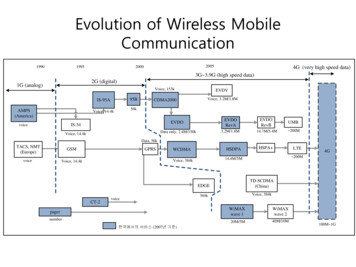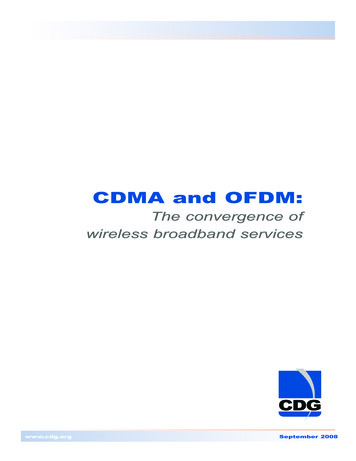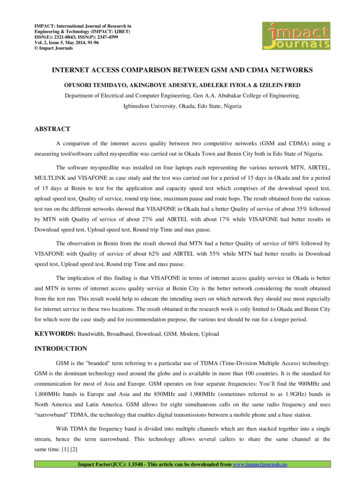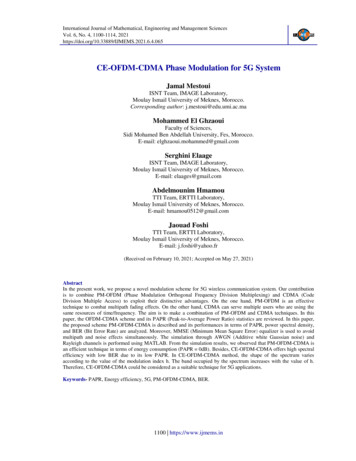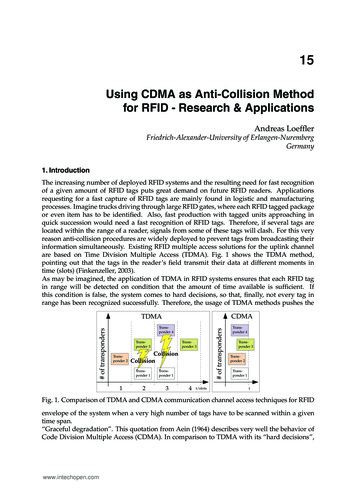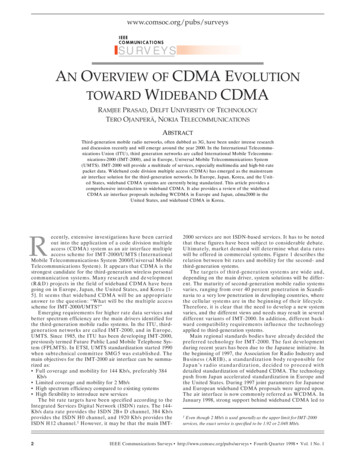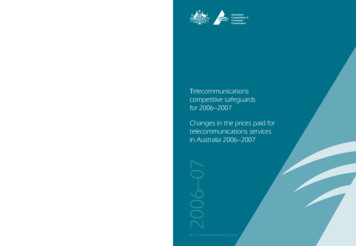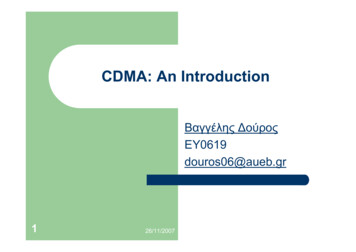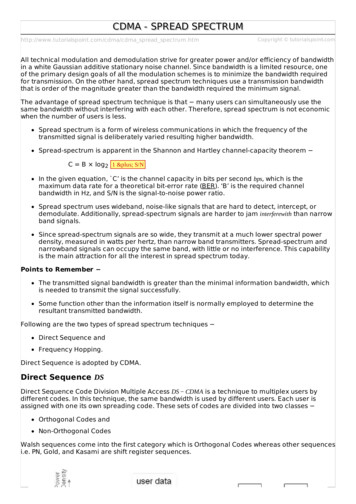
Transcription
CDMA - SPREAD SPECTRUMhttp://www.tutorialspoint.com/cdma/cdma spread spectrum.htmCopyright tutorialspoint.comAll technical modulation and demodulation strive for greater power and/or efficiency of bandwidthin a white Gaussian additive stationary noise channel. Since bandwidth is a limited resource, oneof the primary design goals of all the modulation schemes is to minimize the bandwidth requiredfor transmission. On the other hand, spread spectrum techniques use a transmission bandwidththat is order of the magnitude greater than the bandwidth required the minimum signal.The advantage of spread spectrum technique is that many users can simultaneously use thesame bandwidth without interfering with each other. Therefore, spread spectrum is not economicwhen the number of users is less.Spread spectrum is a form of wireless communications in which the frequency of thetransmitted signal is deliberately varied resulting higher bandwidth.Spread-spectrum is apparent in the Shannon and Hartley channel-capacity theorem C B log2 1 + S/NIn the given equation, C’ is the channel capacity in bits per second bps, which is themaximum data rate for a theoretical bit-error rate (BER). ‘B’ is the required channelbandwidth in Hz, and S/N is the signal-to-noise power ratio.Spread spectrum uses wideband, noise-like signals that are hard to detect, intercept, ordemodulate. Additionally, spread-spectrum signals are harder to jam interferewith than narrowband signals.Since spread-spectrum signals are so wide, they transmit at a much lower spectral powerdensity, measured in watts per hertz, than narrow band transmitters. Spread-spectrum andnarrowband signals can occupy the same band, with little or no interference. This capabilityis the main attraction for all the interest in spread spectrum today.Points to Remember The transmitted signal bandwidth is greater than the minimal information bandwidth, whichis needed to transmit the signal successfully.Some function other than the information itself is normally employed to determine theresultant transmitted bandwidth.Following are the two types of spread spectrum techniques Direct Sequence andFrequency Hopping.Direct Sequence is adopted by CDMA.Direct Sequence DSDirect Sequence Code Division Multiple Access DS CDMA is a technique to multiplex users bydifferent codes. In this technique, the same bandwidth is used by different users. Each user isassigned with one its own spreading code. These sets of codes are divided into two classes Orthogonal Codes andNon-Orthogonal CodesWalsh sequences come into the first category which is Orthogonal Codes whereas other sequencesi.e. PN, Gold, and Kasami are shift register sequences.
Orthogonal codes are assigned to the users, the output of the correlator in the receiver will be zeroexcept the desired sequence. In synchronous direct sequence, the receiver receives the samecode sequence which was transmitted so that there is no time shift between the users.Demodulating DS Signals 1In order to demodulate DS signals, you need to know the code that was used at the time oftransmission. In this example, by multiplying the code used in the transmission to the receptionsignal, we can get the transmitted signal.In this example, multiple codes were used at the time of transmission 10, 110, 100 to the receivedsignal. Here, we have calculated by using the law of two additives Modulo2Addition. It is furtherdemodulated by multiplying the code that was used at the time of this transmission, called thereverse diffusion de spreading. In the diagram given below, it can be seen that during thetransmission of the data to the narrow band NarrowBand spectrum, the spectrum of the signal isdispread.
Demodulating DS Signals 2On the other hand, if you do not know the code that was used at the time of transmission, you willnot be able to demodulate. Here, you are trying to demodulation in the code of different 10101010and the time of transmission, but it has failed.Even looking at the spectrum, it is spreading during the time of transmission. When it is passedthrough a band-pass filter BandPathFilter, only this small signal remains and these are notdemodulated.Features of Spread SpectrumAs shown in the following figure, the power density of Spread Spectrum signals could be lower thanthe noise density. This is a wonderful feature that can keep the signals protected and maintainprivacy.
By spreading the spectrum of the transmitted signal, one can reduce its power density such that itbecomes less than the power density of the noise. In this way, it is possible to hide the signal in thenoise. It can be demodulated if you know the code that was used to send the signal. In case thecode is not known, then the received signal will remain hidden in the noise even after thedemodulation.DS-CDMADS code is used in CDMA. So far, it has been explained basic part of the spread spectrumcommunication. From here, we will explain how Direct Sequence Code Division Multiple AccessDS CDMA works.The signal which is spread spectrum, can be demodulated only by a code used for transmission. Byusing this, the transmission signal of each user can be identified by the separate code when itreceives the signal. In the given example, the spread signal of the user A at the code A, anddiffused signal of user B at code B. Each of the signal when it receives are mixed. However, by theinverse diffuser Despreadder, it identifies the signal of each user.DS-CDMA System - Forward LinkDS-CDMA System - Reverse Link
Spreading CodeCross-CorrelationCorrelation is a method of measurement of how precisely a given signal matches with a desiredcode. In CDMA technology, each user is assigned with a different code, the code which is beingassigned or chosen by the user is very important to modulate the signal because it is related to theperformance of the CDMA system.One will get best performance when there will be clear separation between the signal of desiredusers and signals of the other users. This separation is made by correlating the desired signal codewhich was locally generated and other received signals. If the signal matches with the code of theuser, then the correlation function will be high and the system can extract that signal. If the user'sdesired code has nothing in common with the signal, the correlation should be as close to zero aspossible thuseliminatingthesignal; also known as cross correlation. So, there is a self-correlationSelf Correlation and cross-correlation Cross Correlation.Properties of self-correlation and code are shown in the diagram given below where correlationbetween spreading code ‘A’ and spreading code ‘B’ is shown. In this example, the calculatedcorrelation of spreading code ‘A 1010110001101001 and spreading code ‘B’ 1010100111001001 is given,while performing calculations in below example, the result has come to 6/16.Preferable CodesPreferable code is used in CDMA. There are different codes that can be used depending on thetype of a system of CDMA. There are two types of system Synchronous Synchronous System andAsynchronous Asynchronous System.In a synchronous system, orthogonal codes OrthogonalCode can be used. In asynchronous system forthis, such as pseudo-random code Pseudo randomNoise or Gold code is used.
In order to minimize mutual interference in DS-CDMA, the spreading codes with less crosscorrelation should be chosen.Synchronous DS-CDMAOrthogonal Codes are appropriate. Walshcodeetc.Asynchronous DS-CDMAPseudo-random Noise PN codes/Maximum sequenceGold CodesSynchronous DS-CDMASynchronous CDMA Systems are realized in Point to Multi-point Systems. For example, ForwardLink BaseStationtoMobileStation in Mobile Phone.Synchronization system is used in one-to-many PointtoMultipoint systems. For example, at a giventime, in a mobile communication system, a single base station BTS can communicate with multiplecell phones forwardlink/downlink.In this system, a transmission signal for all the users can communicate in synchronization. Means,"Synchronization" on this point is a sense that can be sent to align the top of each user signal. Inthis system, it is possible to use orthogonal codes and it is also possible to reduce mutualinterference. And orthogonal codes, it is the sign, such as cross-correlation i.e. 0.Asynchronous DS-CDMAIn asynchronous CDMA system, orthogonal codes have bad cross-correlation.Unlike the signal from the base station, the signal from the mobile station to the base station,becomes the asynchronous system.In an asynchronous system, somewhat mutual interference increases, but it uses the other codessuch as PN code or Gold code.
Advantages of Spread SpectrumSince the signal is spread over a wide frequency band, the power spectral density becomes verylow, so other communication systems do not suffer from this kind of communication. However, theGaussian noise increases. Given below is a list of a few major advantages of Spread Spectrum Multipath can be agreed with, as a large number of codes can be generated, allowing a largenumber of users.In spread spectrum, there is no limit of users whereas there is limitations of users in FDMAtechnology.Security without knowing the spreading code, it is hardly possible to recover thetransmitted data.Descending rejection as large bandwidth is used the system; it is less susceptible todeformation.PN SequenceThe DS-CDMA system uses two types of spreading sequences, i.e., PN sequences and orthogonalcodes. As mentioned above, the PN sequenc is generated by the pseudo-random noise generator.It is simply a binary linear feedback shift register, consisting of XOR gates and a shift register. ThisPN generator has the ability to create a sequence identical for both the transmitter and thereceiver, and retaining the desirable properties of the noise randomness bit sequence.A PN sequence has many features such as having an almost equal number of zeros and ones, verylow correlation between shifted versions of the sequence, and very low cross-correlation with othersignals such as interference and noise. However, it is able to correlate well with itself and itsinverse. Another important aspect is the autocorrelation of the sequence as it determines theability to synchronize and lock the spreading code for the received signal. This fight effectivelyeffects the multiple interference and improves the SNR. M-sequences, Gold codes, and Kasamisequences are the examples of this class of sequences.A Pseudo-random Noise PN sequence is a sequence of binary numbers, e.g. 1, whichappears to be random; but it is in fact, perfectly deterministic.PN sequences are used for two types of PN spread spectrum techniques Direct Signal Spread Spectrum DS SS andFrequency Hop spread Spectrum FH SS.If ‘u’ uses PSK for modulating the PN sequence, it results in DS-SS.If ‘u’ uses FSK for modulating the PN sequence, it results in FH-SS.Frequency Hopping TechnologyFrequency hopping is a spread spectrum in which the propagation takes place by hopping infrequency over a wide band. The precise order in which the break occurs is determined by ahopping table generated by using a pseudo-random code sequence.Hopping rate is a function of the speed information. The order of frequencies is selected by thereceiver and is dictated by the pseudo-random noise sequence. Although the transmission of afrequency hopping signal spectrum is quite different from that of a direct sequence signal, itsuffices to note that the data is distributed over a signal band is larger than necessary to carry. Inboth the cases, the resulting signal will appear as noise and the receiver uses a similar technique,which is used in the transmission to recover the original signal.Loading [MathJax]/jax/output/HTML-CSS/jax.js
Asynchronous DS-CDMA In asynchronous CDMA system, orthogonal codes have bad cross-correlation. Unlike the signal from the base station, the signal from the mobile station to the base station, becomes the asynchronous system. In an asynchronous system, somewhat mutual interference increases, but it uses the other codes such as PN code or Gold code.
